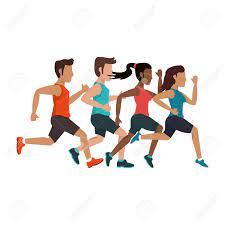Blog
Run Slower to Burn More FAT!
If you’re not getting the results you want from your aerobic workout, maybe you need to run slow down and run slower. Maybe your aerobic workout isn’t burning as much FAT as you think? Maybe it’s time to reevaluate your workout? Unfortunately, a lot of people confuse burning calories with burning FATS! And losing weight by burning muscle instead of the Fat and Flab.
Your body burns calories by breaking down carbohydrates, proteins, and fats for energy. Those are the only 3 options you have. Unfortunately, a lot of people assume when they walk, jog, run, hike, bike, dance, swim, etcetera for 20 minutes or more… they are doing an aerobic exercise and burning FATS. That may be true, depending on how FAST you are going for your level of conditioning.
Aerobic and Anaerobic Exercise
When you go from walking, to jogging, to sprinting your heart rate increases. As it increases, you reach a point or a threshold, around 70% of your maximum heart rate, where you go from aerobic to anaerobic respiration and metabolism. In other words, when you go above 70% of Your Max heart rate, on average – your body can only burn Carbohydrates and Proteins (lean muscle) for energy – Not FATS!
The 70% threshold or tipping point is called your Aerobic Threshold, also called your Fat Burning Zone. When you run slower and train below that 70% threshold, your body can burn FATS. This is because you still have oxygen available and why it’s called aerobic exercise, which means with oxygen.
But as soon as you go over that 70% threshold, you shift into Anaerobic respiration and metabolism, which means without oxygen. The takeaway is that when you go over that 70% aerobic threshold, you metabolize or Can ONLY burn carbohydrates and proteins for energy. Keep in mind, one of the worst mistakes you can make is to burn protein (lean muscle) for energy… But it happens All THE TIME!
This is where Low carb dieters, Early morning exercisers and those who regularly Skip meals, need to be careful, because the worst thing you can do is burn Proteins (lean muscle) for energy!
Slow Down to Burn More Fats
Let’s say you are a 40-year-old person who wants to burn fat when you walk, jog, run, hike, dance, etc. You need to first determine your maximum heart rate to determine your pace. To calculate your maximum heart rate; subtract your age from 220, then multiply by 70%. (220 – 40 = 180); then multiply 180 by 70% (180 x 0.70) = 126 bpm which is your aerobic threshold (fat burning zone).
As long as you walk, jog, dance, hike, etc… Below 126 beats bpm this 40 year old person is aerobic and can burn fats. But if you want to burn more fat… Run slower, jog, walk, dance, hike slower.
Let’s say, this 40-year-old female keeps her heart rate at 120 bpm for the 30-60 minutes she’s exercising. Yes, she is aerobic and burning fat – She is also probably at an 80/20 burn rate. Eighty percent of her calories come from the breakdown of carbohydrates and proteins, and 20% comes from the breakdown of fats.
Now look at what happens when she Slow’s Down her walk, jog, dance, hike, etc… to around 105 bpm. She is still aerobic, but now her burn rate could, for simplicity purposes, flip-flop to 20/80. At the slower pace 20% of her calories burned are from carbohydrates and proteins and 80% of her calorie burn is coming from FATS. In other words, the slower pace is helping her burn more of the Fat and Flab!
The big takeaway is slower is better for burning more FAT. Don’t let your ego get in the way and make you think you need to go faster to get anything out of your workout. I love a good hard work out to build lean muscle. But when I want a fat burning workout – slower is better.
Finding My Fat Burning Zone
Yes, all the books, charts and posters tell you that your fat burning zone is between 50 and 85% of your maximum heart rate. And for the average healthy person it’s about 70% of their max heart rate. But here are a few things the books, charts and posters don’t tell you about finding YOUR Aerobic Threshold. It’s more than simply your age, there are other factors you need to consider.
First, if you’re 20-40 pounds overweight, you’re probably a bit de-conditioned, which would drop that 70% max heart rate threshold down to 65%. If you’re more than 40 pounds overweight, haven’t been exercising regularly, your threshold is closer to 60%. So, slow your butt down if you want to burn fat for energy!
Secondly, you need to realize that ONLY elite endurance runners and triathletes can train at 80% of their max heart rate and still be aerobic. So, if you’re not an elite endurance athlete… slow your butt down! You don’t raise your aerobic threshold in a few weeks, nor do you build 20-inch biceps in a few weeks. It takes months and years of proper training for either to happen.
Food for Thought: Do you think there is a mismatch when your little heart muscle is pumping at 75-85% of its maximum – while your leg muscles are pumping at only 30% of their maximum? I hope that’s helpful and why a good heart rate monitor is your best friend for aerobic workouts.
By Dr. Len Lopez
Eat Right – Train Smart – Think Better


